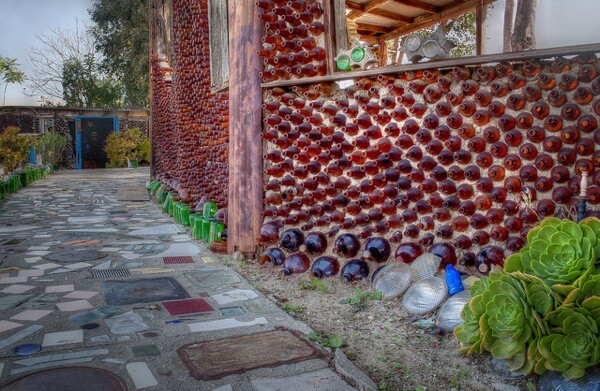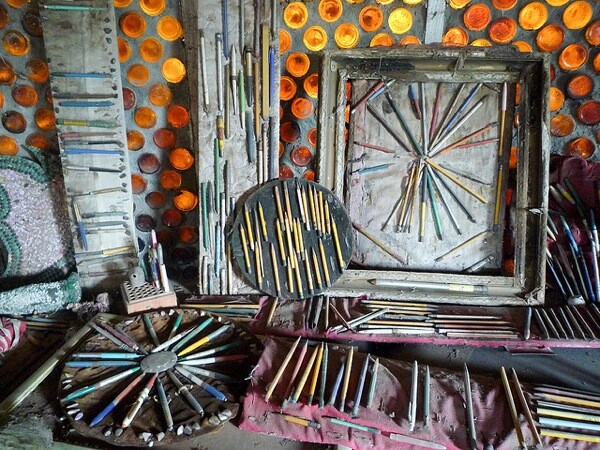Simi Valley's Bottle Village Should Be on Every Tourist's Map

I read recently where Thousand Oaks -- or was it Simi Valley, I can't really remember - was suffering something of an identity crisis. Turns out a restaurant chain called Freddy's Frozen Custard & Steakburgers announced via press release the opening of its' new Thousand Oaks location in "Westlake Village... a suburb of Los Angeles." If you live in Thousand Oaks, you know you don't live in Westlake Village; and if you live in Westlake Village you know you are a suburb of L.A. only in the mind of an addled tourist from Kansas. To be fair, Freddy's Frozen Custard & Steakburgers is a Kansas-based chain. Many Californians would be hard-pressed to name more than three towns in the good state of Kansas (Kansas City -- a gimme -- Wichita, Oz?).
Now the good town of Simi Valley (I think) is working to boost its own presence on the public map. No seriously, it definitely is Simi Valley. The city that is home to the deservedly vaunted Ronald Reagan Museum is working to add Bottle Village to a list of tourist attractions that currently include the Skatelab Indoor Skatepark and Museum, two historical museums and, well, did I mention the Ronald Reagan Museum?
Bottle Village is a fascinating place with an equally fascinating history. Although unknown in Kansas, it is well known in the 4500 block of Cochran Street in Simi Valley. Bottle Village, you should know, is already on the National Register of Historic Places. It's also a designated landmark in the eyes of California, Ventura County, and the city of Simi Valley. Bottle Village is testimony to ingenuity, and the stamina and attention to detail of grandmothers. The small home and its assemblage of shrines, mosaic walkways, wishing wells, and assorted other oddities were built by Grandma Tressa Prisbrey, from 1956 until 1981, almost entirely out of glass bottles. Probably much to the surprise of the now departed Grandma Prisbrey, Bottle Village has a website where you can see photos of energetic Grandma Prisbrey and her work, the artistic cap of trips to the garbage dump beyond number and fathom.
Although it is true that a former Simi Council member once purportedly labeled Bottle Village "a collection of trash," Simi Valley is now trying to put Bottle Village -- and the city of Simi Valley -- on the tourist map. As current Chamber of Commerce executive Leigh Nixon recently told a reporter, "We think the more attractions the better. People say it is unique, and not every community has something like it."
One hurdle between Bottle Village and recognition is simple. Currently, visiting Bottle Village is difficult. Specifically, there were four docent-led tours in 2013. If you are an aficionado of places like Bottle Village, you have one more chance to visit this year. The last docent-led tour of 2013 is December 7.
The good news is the Preserve Bottle Village Committee is working hard to change this. Yes, there is a Preserve Bottle Village Committee. In fact it's been in existence since 1979. But of late the committee has ramped up its efforts with the hopefully not so long term goal of opening Bottle Village to the public on a regular basis. They are fixing things up on the one-third acre lot and inventorying what they have, but mostly they are trying to raise money. Historically, Bottle Village has not had the best luck on this front. After the 1994 Northridge Earthquake severely damaged Grandma Prisbrey's labor of love, Bottle Village was in line for $450,000 in FEMA funding until then-Congressman Elton Gallegly wrote a bill to cut off the funding. Congressman Gallegly saw the restoration of Bottle Village as a waste of money. Given the proclivities of government spending, this was not only a financial blow to Bottle Village but a stinging slap in the face. Now the Preserve Bottle Village Committee is working quietly to raise money on its own. I must point out that they are sitting on a gold mine of recyclables.
It is interesting to me what people find interesting. God knows, countless cities and towns have tried to figure out how to draw tourists. Here in California, we have more than our share of off-beat attractions, including The World's Largest Thermometer (Baker), the Pez Museum (Burlingame), and Confusion Hill Gravity House (Piercy). All of them, landmarks designed to put their town on the map.
Odds are your reaction was the same as mine. Where is Piercy?
Don't get me wrong. I love these attractions. They are testament to individualism, perseverance, creativity, and perhaps a hint of desperation. Many of them are fascinating, educational, charming, and worth the $3 admission. The best of them are unforgettable.
Odds are, you've never heard of my favorite tourist attraction, designed to put Staniel Cay on the map. Okay. Staniel Cay is a tiny speck of island lost among the 700-some islands of the Bahamas, probably why the inhabitants of Staniel Cay trumpet (as best as they can) adjacent Pig Island.
It was early evening, the sun just beginning to soften, when I visited Pig Island with Staniel Cay resident Ray Leese. Most of the world was settling down with their remotes and Facebook chatter as Ray and I swung our legs over the side of the skiff and plunked into shin deep water. Almost immediately, four pigs trotted briskly down the beach to meet us.
"There are a lot more of them," said Ray, standing beside me. "It really is Pig Island."
Perhaps he thought I was disappointed, but four was more than enough for me. The three piglets were small, but the sow possessed impressive heft. She plunged into the water like a bristly amphibious vessel, heading directly for me. She seemed to grow in size with each splash and chuff. For a brief instant I considered running, but I mustered my courage.
Ray had also grabbed my elbow.
"Steady now," he said. "The sow's not shy. She'll come right up to you."
She did exactly that, thrusting her snout into an area that made me even more uncomfortable. Standing in bathtub warm water, Mrs. Piggy continued snuffling, becoming fresher by the second.
Her offspring circled us, bobbing like hairy corks in the pinkish light. They were impossibly cute.
Like any good tour guide, Ray knew what to say.
"Pig Island's a big hit with the kids. They like it better than Disneyland."
Mrs. Piggy gave a grunt to help me along.
"Guess she's expectin' something," observed Ray. "Boaters come out and feed 'em all the time."
This was well and good, but it didn't make me feel any better because I had neglected to bring anything to eat.
For several long moments Mrs. Piggy continued to fix me with slit-eyed hope. Finally she turned her back on me and waded to shore, but not without a parting grunt of disgust.
Ray grinned.
"Yea, she's a little dejected, but she'll get over it. Life goes on."
She might have been disappointed but I was not. I have not forgotten my visit to Pig Island, and Staniel Cay. It was the most effective of attractions. Not every community has something like it.

Which is why I wish the Preserve Bottle Village Committee and the city of Simi Valley the best of luck. When (not if) Bottle Village opens full-time, I will be one of the first in what I hope is a long line.
Cities need to be noticed. Tourists bring dollars and, with time, recognition and more tourists, so that a visitor from Kansas might one day easily say, "Hey, let's visit Bottle Village and then stop in Thousand Oaks for a frozen custard, even though it's a long way from L.A."
But not everyone cares to be noticed. Although I never had the pleasure of meeting Grandma Prisbrey, I doubt she or the pigs of Pig Island longed for recognition, although with pigs it's hard to tell. My guess is Grandma Prisbrey did what she did to satisfy some deep-seated urge of her own.
I once met a man who built a bar made entirely of seashells. I saw his bar. It was five feet long, four feet high, three feet thick; seashells all the way through. Every day he walked up to ten miles of beach, admiring how the light fell on the water, collecting whatever the ocean had washed ashore.
When I asked him why he did this, he rubbed his goatee and smiled.
"Can you think of anything better to do?"
That, in my mind, is why Bottle Village and Simi Valley should be on everyone's map.


